| Bogleech Presents The Top Twenty Coolest Flies - Part II |
| #4 - Vestigipoda - the false ant larvae |
Ants aren't off the hook yet, (not by a long shot. You'll see.) as we have yet another fly adapted to take
advantage of social insect hospitality, and even a relative of the termite-loving weirdos at #9. What you're
looking at here may resemble a maggot, but take a better look and you'll find the head and thorax of an adult
fly. The "maggot" is merely the enormous abdomen of this wingless, even legless female phorid fly, and it
perfectly imitates ant larvae of the genus Aenictus down to the all-important smell. These plump, lazy ladies
end up carried, fed and fiercely protected by a roving horde of highly aggressive army ants, who ought to be
more suspicious when some of their "larvae" are visited by tiny, flying males. They grow up so fast.
advantage of social insect hospitality, and even a relative of the termite-loving weirdos at #9. What you're
looking at here may resemble a maggot, but take a better look and you'll find the head and thorax of an adult
fly. The "maggot" is merely the enormous abdomen of this wingless, even legless female phorid fly, and it
perfectly imitates ant larvae of the genus Aenictus down to the all-important smell. These plump, lazy ladies
end up carried, fed and fiercely protected by a roving horde of highly aggressive army ants, who ought to be
more suspicious when some of their "larvae" are visited by tiny, flying males. They grow up so fast.
| #3 - Diopsidae - the Stalk-eyed Flies |
If for some strange reason you're beginning to get tired of bloodthirsty parasites and predators, here's a
family of cute little weirdos who wouldn't hurt a...different fly. Feeding on fungi, bacteria and decaying
vegetation near bodies of water, the Diopsids or "stalk-eyed" flies are named for the bizarre head shape of
the males, whose eyes and antennae are held apart on handlebar-like stems. Females are attracted to
males with the widest eye-span, and competing males will face one another in comical waggling-matches to
compare their stalk length, even inhaling air to bug their eyes out even farther. As female preference breeds
males with ever longer stalks, males have a more difficult time actually flying; their exaggerated symbol of
masculinity impairing their vision. Anything for the ladies.
family of cute little weirdos who wouldn't hurt a...different fly. Feeding on fungi, bacteria and decaying
vegetation near bodies of water, the Diopsids or "stalk-eyed" flies are named for the bizarre head shape of
the males, whose eyes and antennae are held apart on handlebar-like stems. Females are attracted to
males with the widest eye-span, and competing males will face one another in comical waggling-matches to
compare their stalk length, even inhaling air to bug their eyes out even farther. As female preference breeds
males with ever longer stalks, males have a more difficult time actually flying; their exaggerated symbol of
masculinity impairing their vision. Anything for the ladies.
| #2 - Arachnocampa luminosa - the glowing spider-worms |
| Written by Jonathan Wojcik |
| #1 - Pseudacteon - the decapitating parasitoid |
| #5 - Mystacinobia - the New Zealand Bat Fly |
| #8 - Oestridae - the Bot Flies |
The much-maligned bot-flies have no mouths and cannot feed as plump, fuzzy adults, but spend their
notorious larval stage buried in the still-living flesh of a vertebrate host. Different species prefer different
mammals as incubators, but typically lay their eggs on other insects to make the delivery for them.
Dermatobia hominis, the human botfly, stalks her host from a safe distance until she spies a hungry female
mosquito. She wrestles her fellow dipteran in mid-air to lay dozens of tiny eggs on its abdomen, which will
hatch when the mosquito lands on a warm human body...
notorious larval stage buried in the still-living flesh of a vertebrate host. Different species prefer different
mammals as incubators, but typically lay their eggs on other insects to make the delivery for them.
Dermatobia hominis, the human botfly, stalks her host from a safe distance until she spies a hungry female
mosquito. She wrestles her fellow dipteran in mid-air to lay dozens of tiny eggs on its abdomen, which will
hatch when the mosquito lands on a warm human body...
| Photo by Charley Eisman |
A species so unique it was given its own genus and family, Mystacinobia zelandica is a blind, wingless,
long-limbed insect specially adapted to climb through the fur of Mystacina tuberculata, New Zealand's lesser
short-tailed bat. By now, wingless symbiotic flies are probably getting old (welcome to bogleech.com!), but
these guys are among those rare insects to be welcomed in a mammal's fur. Their bat roommates, who prey
heavily on insects, pay no mind at all while these plump morsels scuttle all over their bodies. It's not blood the
bugs are after, but nutrient-rich guano; the insects live entirely off residual feces they clean from the host fur.
It's like one of those living hygiene products on The Flintstones.
long-limbed insect specially adapted to climb through the fur of Mystacina tuberculata, New Zealand's lesser
short-tailed bat. By now, wingless symbiotic flies are probably getting old (welcome to bogleech.com!), but
these guys are among those rare insects to be welcomed in a mammal's fur. Their bat roommates, who prey
heavily on insects, pay no mind at all while these plump morsels scuttle all over their bodies. It's not blood the
bugs are after, but nutrient-rich guano; the insects live entirely off residual feces they clean from the host fur.
It's like one of those living hygiene products on The Flintstones.
| Photo by the Malaysian Macro Team |
| #9 - Thaumatoxena |
The internet's only image of this obscure oddity seems to be this illustration of the mature female, and yes,
we are looking at her entire body. Her abdomen is dominated by a single segment, her wings are pointed
stubs and her head is a thin crescent, with eye-like sockets for her blunt antennae. Her simplified anatomy
fits together in a smooth, durable "pill" scarcely larger than your average mite, and as you might have
guessed if you've been paying attention, the degenerate form suits a highly specific lifestyle in close
symbiosis with another creature; in this case, termites. Agriculturists may be pleased to know that insects put
up with pests of their own, as these turtle-like flies live off the symbiotic fungus gardens of their hosts. The
winged males were once mistaken for a separate species; their more conventional form allows them to travel
from one termite nest to another.
we are looking at her entire body. Her abdomen is dominated by a single segment, her wings are pointed
stubs and her head is a thin crescent, with eye-like sockets for her blunt antennae. Her simplified anatomy
fits together in a smooth, durable "pill" scarcely larger than your average mite, and as you might have
guessed if you've been paying attention, the degenerate form suits a highly specific lifestyle in close
symbiosis with another creature; in this case, termites. Agriculturists may be pleased to know that insects put
up with pests of their own, as these turtle-like flies live off the symbiotic fungus gardens of their hosts. The
winged males were once mistaken for a separate species; their more conventional form allows them to travel
from one termite nest to another.
| #10 Acroceridae - the small-headed spider parasites |
These hump-backed pinheads look harmlessly silly, but as larvae, they're killer parasitoids of fly-kind's
classic enemies, the spiders. The roly-poly adults would probably get themselves caught if they went after a
spider directly, but their highly active larvae are fully equipped to hunt one down on their own and will even
ride the wind to disperse themselves, a tactic also employed by baby spiders themselves. Once it finds a
juicy arachnid (usually a trap-door spider) the little maggot climbs a leg and usually bores right into the
spider's body, though at least one species will first cut a tiny hole in the host's side and molt into an entirely
new form, thin and soft enough to slip through. The larger form protects it on the quest for a host, while the
thinner form can get inside without causing as much damage to its new home. When the time comes to
pupate, it will finally kill the spider and consume what's left from the inside.
classic enemies, the spiders. The roly-poly adults would probably get themselves caught if they went after a
spider directly, but their highly active larvae are fully equipped to hunt one down on their own and will even
ride the wind to disperse themselves, a tactic also employed by baby spiders themselves. Once it finds a
juicy arachnid (usually a trap-door spider) the little maggot climbs a leg and usually bores right into the
spider's body, though at least one species will first cut a tiny hole in the host's side and molt into an entirely
new form, thin and soft enough to slip through. The larger form protects it on the quest for a host, while the
thinner form can get inside without causing as much damage to its new home. When the time comes to
pupate, it will finally kill the spider and consume what's left from the inside.
| #6 - Asilidae - the Robber Flies |
Something that just might save your life from #7, almost no bug is too small, too big or too venomous for a
robber fly's ravenous appetite. These raptors* of the insect world will swoop in to pluck insects from the
ground, tear spiders from their webs and grapple even far larger wasps or dragonflies (above) right out of
the air, carrying them off to a preferred perch for consumption. Their short, bladed mouth-parts can saw
through the slightest chink in an exoskeleton, pumping prey full of neurotoxic saliva and digestive enzymes.
The victim is paralyzed almost instantaneously as its innards begin to break down, and only its empty shell
will remain when the fly is satiated.
robber fly's ravenous appetite. These raptors* of the insect world will swoop in to pluck insects from the
ground, tear spiders from their webs and grapple even far larger wasps or dragonflies (above) right out of
the air, carrying them off to a preferred perch for consumption. Their short, bladed mouth-parts can saw
through the slightest chink in an exoskeleton, pumping prey full of neurotoxic saliva and digestive enzymes.
The victim is paralyzed almost instantaneously as its innards begin to break down, and only its empty shell
will remain when the fly is satiated.
| #7 Cochliomyia - the Screwworm Flies |
Cochliomyia hominovorax means "spiral maggot man-eater," and was eradicated in the United States as of
1982 with more extermination programs active around the globe (bogleech.com does not endorse the
genocide of terrifying animals). This species of blowfly (like the less dangerous bluebottles and
greenbottles common around garbage) reproduces only in living tissue, laying over a thousand tiny eggs
near any wound it can find on the host's body - even as small as a tick bite. Within twelve hours, the eggs
hatch and the maggots begin to tunnel painfully through healthy flesh, creating a bigger, deeper wound that
can immediately take on infection, necrotizing (ROTTING) and smelling even more attractive to flies -
especially to more female screwworms, who can smell the ideal nursery miles downwind. Left untreated, wave
after wave of maggots will hatch and feed in the same wound for as long as the host has living tissue to
consume, which may not be long if the infections can't be treated.
...What?
How is that not cool?
You're weird.
1982 with more extermination programs active around the globe (bogleech.com does not endorse the
genocide of terrifying animals). This species of blowfly (like the less dangerous bluebottles and
greenbottles common around garbage) reproduces only in living tissue, laying over a thousand tiny eggs
near any wound it can find on the host's body - even as small as a tick bite. Within twelve hours, the eggs
hatch and the maggots begin to tunnel painfully through healthy flesh, creating a bigger, deeper wound that
can immediately take on infection, necrotizing (ROTTING) and smelling even more attractive to flies -
especially to more female screwworms, who can smell the ideal nursery miles downwind. Left untreated, wave
after wave of maggots will hatch and feed in the same wound for as long as the host has living tissue to
consume, which may not be long if the infections can't be treated.
...What?
How is that not cool?
You're weird.

| Photographed by Jorge Almeida |
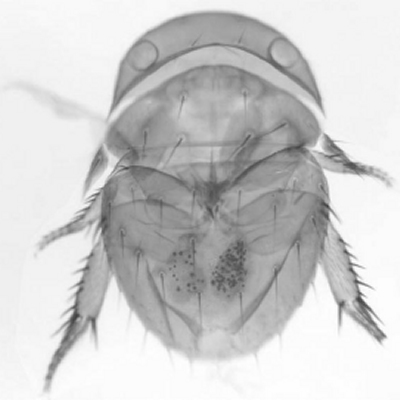
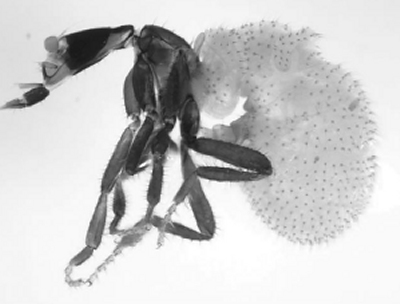
| HONORABLE MENTION: TERMITOXENIA |
Also too rare to have been photographed, Termitoxenia is relatively more normal looking than
Thaumatoxena, but both belong to the family Phoridae. Termitoxenia seem to secrete substances that
termites find appetizing, and their reduced wings are even used as handles by the termites to carry them
around.
Thaumatoxena, but both belong to the family Phoridae. Termitoxenia seem to secrete substances that
termites find appetizing, and their reduced wings are even used as handles by the termites to carry them
around.


Heavily barbed to resist easy extraction, each maggot may grow over an inch in length under the host's skin,
spending its entire larval stage upside-down in a mucus-lined chamber, exposing only the tip of its
snorkel-like tail to breathe. Fortunately, the larvae keep a fairly clean home - bacterial infections only seem
to occur if the maggot dies - and will exit harmlessly when the time comes to pupate. Horror stories of these
maggots embedded in the eye or vital organs are isolated, freak incidents, and the safest way to get rid of
one is to simply let it run its course.
Other species of bot-fly are internal parasites. Gasterophilus lay their eggs on the fur or around the lips of
grazing mammals such as horses and cattle; licked into the mouth by the host, the maggots bore into the
tongue or gums until they grow larger and allow themselves to be swallowed. Their barbs and hooks anchor
them to the walls of the digestive tract until they pupate, passing out of the body in feces.
spending its entire larval stage upside-down in a mucus-lined chamber, exposing only the tip of its
snorkel-like tail to breathe. Fortunately, the larvae keep a fairly clean home - bacterial infections only seem
to occur if the maggot dies - and will exit harmlessly when the time comes to pupate. Horror stories of these
maggots embedded in the eye or vital organs are isolated, freak incidents, and the safest way to get rid of
one is to simply let it run its course.
Other species of bot-fly are internal parasites. Gasterophilus lay their eggs on the fur or around the lips of
grazing mammals such as horses and cattle; licked into the mouth by the host, the maggots bore into the
tongue or gums until they grow larger and allow themselves to be swallowed. Their barbs and hooks anchor
them to the walls of the digestive tract until they pupate, passing out of the body in feces.
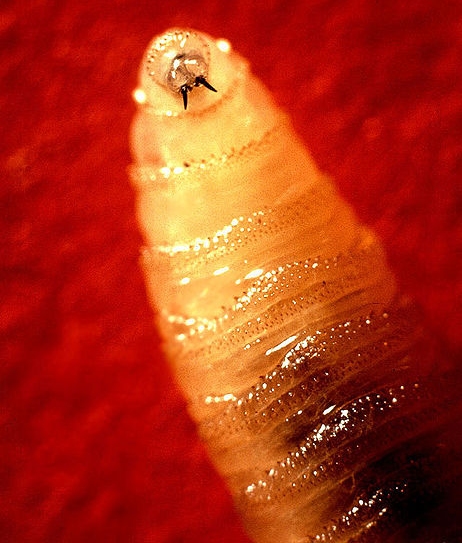
Bot flies are weird, fascinating parasites and I'm inclined to find them a bit cooler, but I'm not sure how they've
managed to earn quite so much infamy. Find any article on "horrifying" insects and bot flies are likely to top
the list, with barely a mention of the screwworm flies. Sure, botfly maggots are a lot larger, but they don't
normally cause any long-term harm to the host and certainly aren't lethal under any normal circumstances.
Not so for screwworm maggots, whose vast numbers can maim or even kill hosts as large as full-grown cattle.
Let's let that sink in a moment. Maggots that can eat a cow to death. Maggots that have eaten human beings
to death. Maggots that could eat you to death.
managed to earn quite so much infamy. Find any article on "horrifying" insects and bot flies are likely to top
the list, with barely a mention of the screwworm flies. Sure, botfly maggots are a lot larger, but they don't
normally cause any long-term harm to the host and certainly aren't lethal under any normal circumstances.
Not so for screwworm maggots, whose vast numbers can maim or even kill hosts as large as full-grown cattle.
Let's let that sink in a moment. Maggots that can eat a cow to death. Maggots that have eaten human beings
to death. Maggots that could eat you to death.

| Another photograph by the amazing Thomas Shahan |
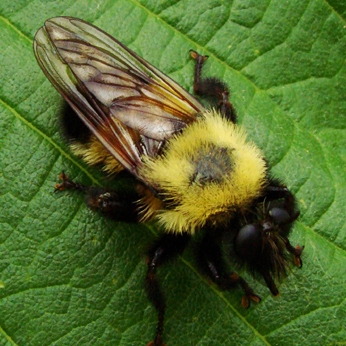
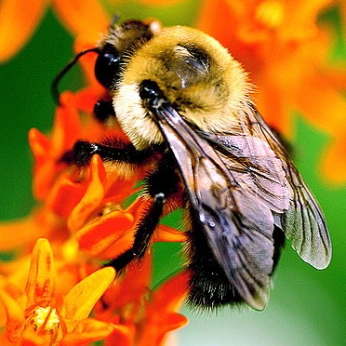
Though they will not hesitate to attack other insects, many robber flies specialize in stalking bees or wasps,
and may closely (in this case, very closely) resemble their preferred prey. Could you tell apart the fly from the
bumblebee at first glance?
and may closely (in this case, very closely) resemble their preferred prey. Could you tell apart the fly from the
bumblebee at first glance?
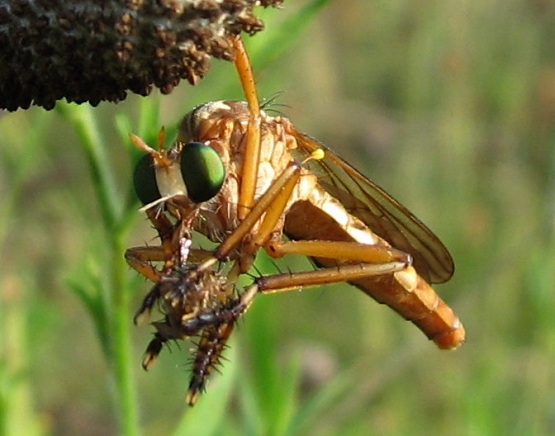
Never letting their guard down, many robber flies are known to feed while hanging by only a leg or two, ready
to drop like a rock and take off in mid-fall if anything sneaks up on them. Their fast-acting venom is usually
enough to overpower prey, but a thick, bristly "moustache" further protects their head from the jaws or
stingers of a struggling meal.
*That's predatory birds, not dinosaurs.
to drop like a rock and take off in mid-fall if anything sneaks up on them. Their fast-acting venom is usually
enough to overpower prey, but a thick, bristly "moustache" further protects their head from the jaws or
stingers of a struggling meal.
*That's predatory birds, not dinosaurs.
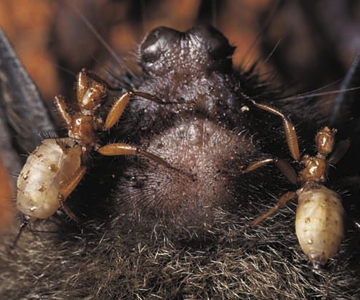
| Photo by Rod Morris |
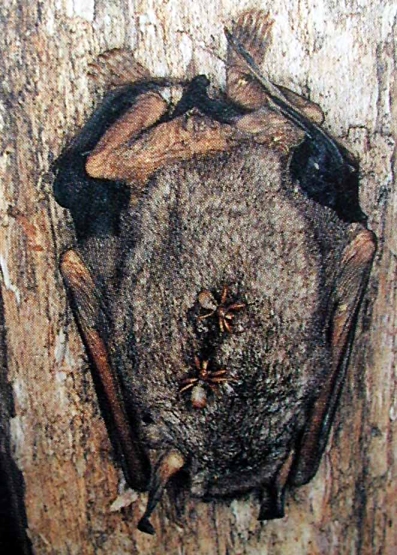
Far more social than most other flies, Mystacinobia raise their eggs and young in communal nurseries near
the roosts of their bat hosts. Females carefully groom one another and their larvae, while special males live
beyond their usual lifespan, cease reproducing and become a sort of elder guardian caste, emitting a
collective buzz which apparently tells bats to keep a safe distance from the nursery. An ingenious course of
evolution for what amounts to bat toilet paper.
the roosts of their bat hosts. Females carefully groom one another and their larvae, while special males live
beyond their usual lifespan, cease reproducing and become a sort of elder guardian caste, emitting a
collective buzz which apparently tells bats to keep a safe distance from the nursery. An ingenious course of
evolution for what amounts to bat toilet paper.
| "Bzzz! It's a livin!" |
| HONORABLE MENTION: Nycteribiidae |

| A rare and fantastic capture by Jorge Almeida |
While the New Zealand bat fly is a single species in its own distinct family, the Nycteribiidae are a family of
several hundred "bat flies" completely unrelated to Mystacinobia. They may look like sisters on the outside,
but they're scarcely second cousins, belonging to two different superfamilies of the three that form the
Diptera. Unlike our gentle poo-eaters, these other guys are true blood-sucking parasites, and will never
leave their bat host's body as adults. Unlike any other insects but the closely related louseflies, their larval
stage completes its development still inside the mother's body, and she will lay pupa instead of eggs. If you're
looking for the head in this monstrosity, it's the pointed, nearly featureless lump between the front legs.
several hundred "bat flies" completely unrelated to Mystacinobia. They may look like sisters on the outside,
but they're scarcely second cousins, belonging to two different superfamilies of the three that form the
Diptera. Unlike our gentle poo-eaters, these other guys are true blood-sucking parasites, and will never
leave their bat host's body as adults. Unlike any other insects but the closely related louseflies, their larval
stage completes its development still inside the mother's body, and she will lay pupa instead of eggs. If you're
looking for the head in this monstrosity, it's the pointed, nearly featureless lump between the front legs.
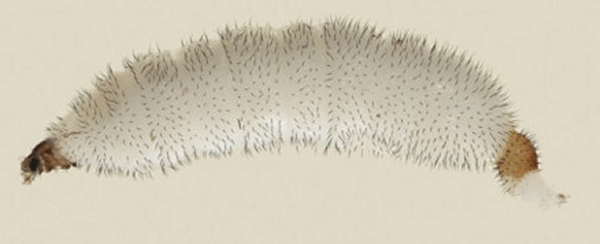
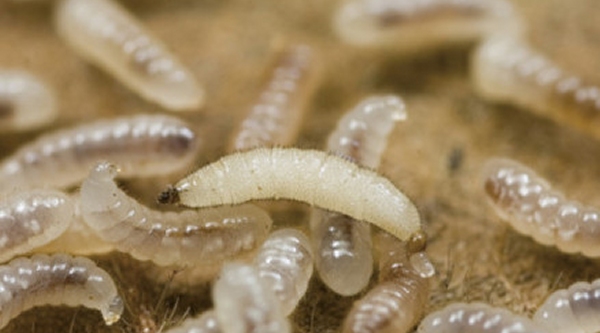
| An impostor surrounded by normal ant larva |
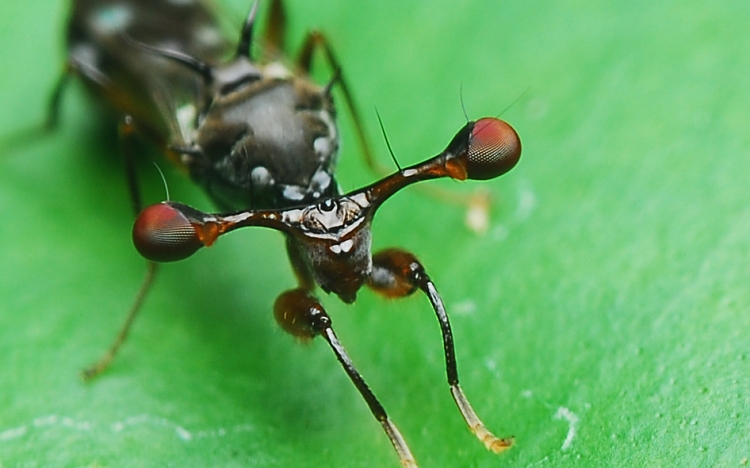
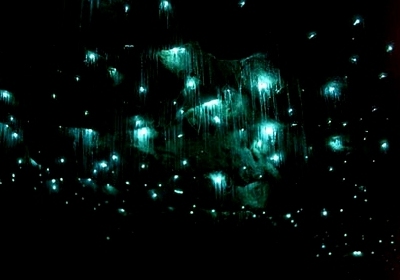

Dwelling in a hammock-like tube of slime, the transparent worm spins dozens of hanging silken threads and
beads them with extremely sticky, sometimes even poisonous globules of mucus, illuminated by the waste
product of symbiotic bacteria. As I explain arguably better on Cracked.com, the collective light show of
these slimy bug-anglers effectively lures moths, mosquitoes and other night-flying insects right into their
sticky snares, and may even fool such prey into seeing the starlit sky, preventing them from finding a way
out of the deadly cave. Once it feels a tug on its fishing line, the maggot simply eats the entire strand,
insect and all.
Though hardly in such spectacular concentration, different species of these killer lanterns can be found in
a number of caves, canyons, dense forests and other dark, environments where the still air won't disturb
their traps. Most are native to Australia, but a few inhabit North America, including a huge colony in Dismals
Canyon, Alabama - carrying the awesome local nickname "Dismalites." The short-lived adult gnats can
glow, but don't do so often and apparently don't need to. They are far from immune to the sticky traps of
younger cousins, but lay more than enough eggs to compensate for the loss.
You can watch a spectacular BBC video of the entire hunting process here, with Sir Attenborough!
beads them with extremely sticky, sometimes even poisonous globules of mucus, illuminated by the waste
product of symbiotic bacteria. As I explain arguably better on Cracked.com, the collective light show of
these slimy bug-anglers effectively lures moths, mosquitoes and other night-flying insects right into their
sticky snares, and may even fool such prey into seeing the starlit sky, preventing them from finding a way
out of the deadly cave. Once it feels a tug on its fishing line, the maggot simply eats the entire strand,
insect and all.
Though hardly in such spectacular concentration, different species of these killer lanterns can be found in
a number of caves, canyons, dense forests and other dark, environments where the still air won't disturb
their traps. Most are native to Australia, but a few inhabit North America, including a huge colony in Dismals
Canyon, Alabama - carrying the awesome local nickname "Dismalites." The short-lived adult gnats can
glow, but don't do so often and apparently don't need to. They are far from immune to the sticky traps of
younger cousins, but lay more than enough eggs to compensate for the loss.
You can watch a spectacular BBC video of the entire hunting process here, with Sir Attenborough!

| Image taken by Teejaybee of a forest-dwelling species - don't miss some of their other gorgeous wildlife photos, click the link! |
New Zealand's Glow Worm Cave is hailed by scientists and tourists alike as one of the world's most beautiful
living wonders, but the twinkling fairy-lights have a far from romantic source; they're the mucus strands of
predatory fungus gnat maggots, illuminated by bacteria. No, not romantic...what's a better word for that? How
about METAL?
living wonders, but the twinkling fairy-lights have a far from romantic source; they're the mucus strands of
predatory fungus gnat maggots, illuminated by bacteria. No, not romantic...what's a better word for that? How
about METAL?
Imagine waking up one morning to find half the neighborhood walking around in a trance. They
stumble about blindly and stupidly for days, until one by one, their necks tear open and their heads
tumble to the ground. Weeks go by, their rotting skulls littering their homes and gardens, occasionally
twitching. One morning, all together, the severed craniums begin to shudder and crack like bird's
eggs. A hunched, hairy, huge-eyed creature breaks its way out of each decayed scalp, pumps blood
into its shrunken wings, and flies away to the next town.
stumble about blindly and stupidly for days, until one by one, their necks tear open and their heads
tumble to the ground. Weeks go by, their rotting skulls littering their homes and gardens, occasionally
twitching. One morning, all together, the severed craniums begin to shudder and crack like bird's
eggs. A hunched, hairy, huge-eyed creature breaks its way out of each decayed scalp, pumps blood
into its shrunken wings, and flies away to the next town.
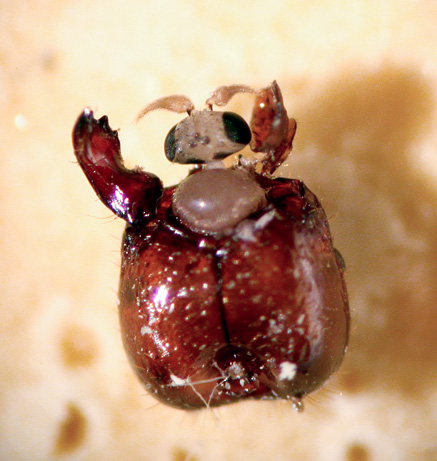
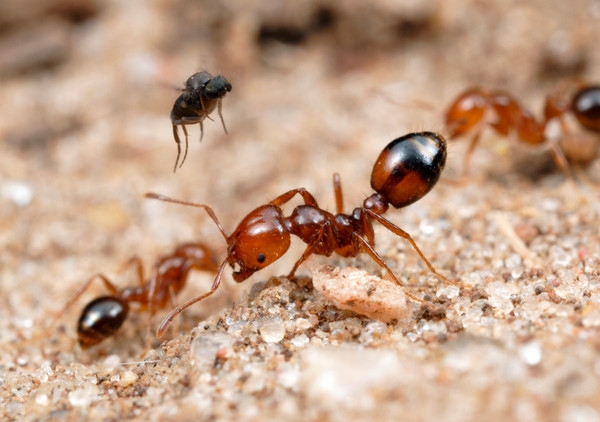
Pseudacteon are a genus of phorid fly (like #4 and #9) which exclusively parasitizes ants (what did I
say? They have bigger fly problems than you do by far) especially the dreaded Solenopsis or "fire"
ants. These invasive, aggressive, venomous ants are the terror of all other insects and even many
vertebrates, but fly into a futile panic when their antennae pick up the distinct buzzing of a single tiny
Pseudacteon.
Swooping down on the first worker she can catch, the mother fly inserts her needle-like ovipositor
(egg-laying tube) into an ant's thorax and lays a single egg in the blink of an eye. Once hatched, the
maggot makes its way into the host's head, where it feeds on hemolymph, muscle tissue and nervous
tissue. When it finally devours the last of the ant's brain, the host wanders aimlessly for up to two
weeks until the parasite dissolves the connective tissues of its neck, causing the entire head to drop
clean off. This will serve as a tough protective casing while the maggot pupates, and the adult will
carefully saw its way out or squeeze through the former ant's mouth.
say? They have bigger fly problems than you do by far) especially the dreaded Solenopsis or "fire"
ants. These invasive, aggressive, venomous ants are the terror of all other insects and even many
vertebrates, but fly into a futile panic when their antennae pick up the distinct buzzing of a single tiny
Pseudacteon.
Swooping down on the first worker she can catch, the mother fly inserts her needle-like ovipositor
(egg-laying tube) into an ant's thorax and lays a single egg in the blink of an eye. Once hatched, the
maggot makes its way into the host's head, where it feeds on hemolymph, muscle tissue and nervous
tissue. When it finally devours the last of the ant's brain, the host wanders aimlessly for up to two
weeks until the parasite dissolves the connective tissues of its neck, causing the entire head to drop
clean off. This will serve as a tough protective casing while the maggot pupates, and the adult will
carefully saw its way out or squeeze through the former ant's mouth.
| Photo by Alex Wild |
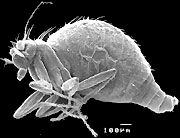
| HONORABLE MENTION 2: WANDOLLECKIA ACHATINAE |
The flightless females of another phorid bear some slight resemblance to the Termitoxenia, but these girls
live in the oddest place of all; swimming in and feeding on the slime of the giant land snail, Achatina
achatina. We know very little of their life cycle, except that males are winged and land on snails only to find a
mate. Females and larvae are probably spread between snails by contact, or when one snail passes over the
slime trail of another.
live in the oddest place of all; swimming in and feeding on the slime of the giant land snail, Achatina
achatina. We know very little of their life cycle, except that males are winged and land on snails only to find a
mate. Females and larvae are probably spread between snails by contact, or when one snail passes over the
slime trail of another.
| The top 20 flies mercilessly cannibalized one of my older articles: flightless flies |